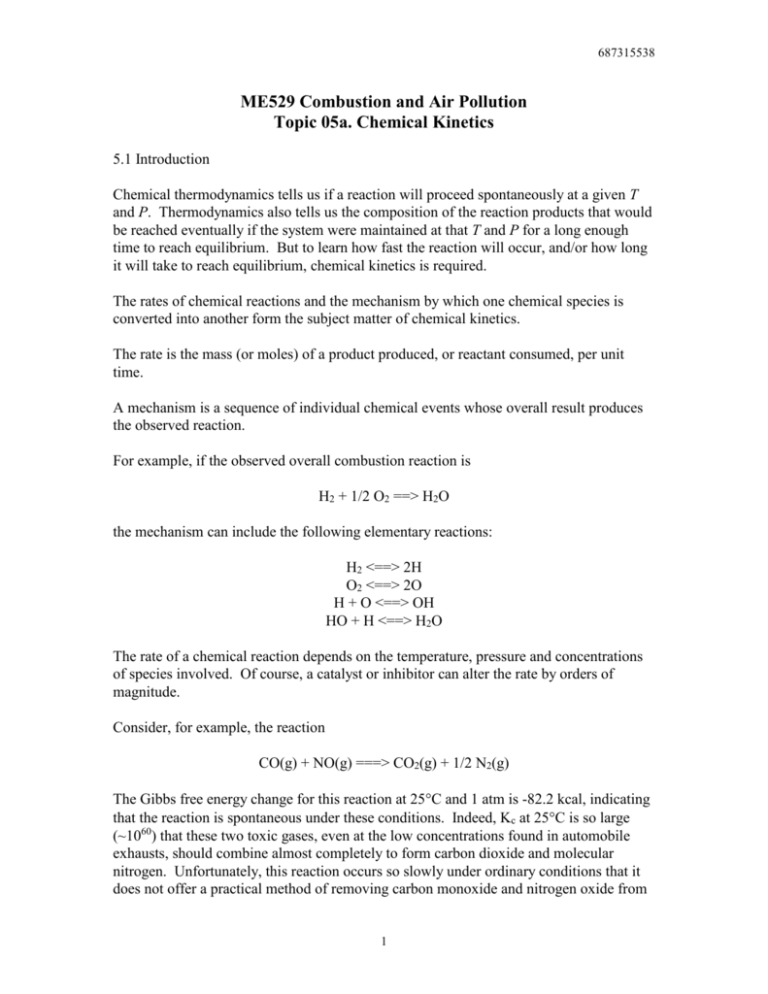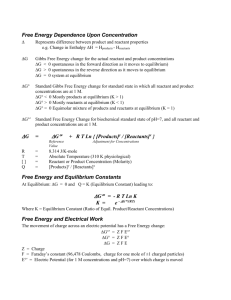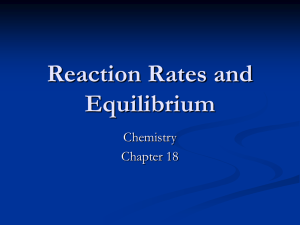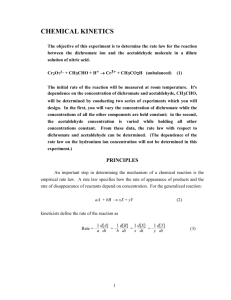Chemical Kinetics Notes
advertisement

687315538 ME529 Combustion and Air Pollution Topic 05a. Chemical Kinetics 5.1 Introduction Chemical thermodynamics tells us if a reaction will proceed spontaneously at a given T and P. Thermodynamics also tells us the composition of the reaction products that would be reached eventually if the system were maintained at that T and P for a long enough time to reach equilibrium. But to learn how fast the reaction will occur, and/or how long it will take to reach equilibrium, chemical kinetics is required. The rates of chemical reactions and the mechanism by which one chemical species is converted into another form the subject matter of chemical kinetics. The rate is the mass (or moles) of a product produced, or reactant consumed, per unit time. A mechanism is a sequence of individual chemical events whose overall result produces the observed reaction. For example, if the observed overall combustion reaction is H2 + 1/2 O2 ==> H2O the mechanism can include the following elementary reactions: H2 <==> 2H O2 <==> 2O H + O <==> OH HO + H <==> H2O The rate of a chemical reaction depends on the temperature, pressure and concentrations of species involved. Of course, a catalyst or inhibitor can alter the rate by orders of magnitude. Consider, for example, the reaction CO(g) + NO(g) ===> CO2(g) + 1/2 N2(g) The Gibbs free energy change for this reaction at 25C and 1 atm is -82.2 kcal, indicating that the reaction is spontaneous under these conditions. Indeed, Kc at 25C is so large (~1060) that these two toxic gases, even at the low concentrations found in automobile exhausts, should combine almost completely to form carbon dioxide and molecular nitrogen. Unfortunately, this reaction occurs so slowly under ordinary conditions that it does not offer a practical method of removing carbon monoxide and nitrogen oxide from 1 687315538 polluted air. However, when that polluted air can be passed over a suitable catalyst at a higher temperature, the reaction can efficiently remove CO and NO. This reaction is the basis for 2 of the 3 pollutants removed by the catalytic converters on gasoline-powered automobiles (the third pollutant removed is HC by another reaction - more on 3-way catalytic converters later when we discuss spark ignition engines). Hence, there is no direct correlation between the rate of a reaction and the thermodynamic driving force as expressed by the free energy change of the equilibrium constant. A different set of principles, which encompass chemical kinetics, must be used to predict how rapidly a reaction occurs. 5.2 Rate Constant Consider the overall reaction between CO and nitrogen oxide: CO(g) + NO(g) ===> CO2(g) + 1/2 N2(g) The rate of this reaction is the change in concentration (rate of formation) of one of the products, or the negative change in concentration (rate of destruction) of one of the reactants, i.e., rate d CO2 d CO dt dt Because of the 1:1 stoichiometry of the reaction, these two rate expressions are equivalent. For every mole of CO2 formed, one mole of CO disappears. The rate is proportional to the concentrations of the reactants. rate kCONO The proportionality constant k is the rate constant for the reaction. k is a function of temperature only and for overall reactions it is independent of the concentrations of reactants. For a general reaction aA(g) + bB(g) ===> products the rate expression takes the form rate = k [A]m [B]n 2 687315538 The powers m and n describe the order of the reaction. The reaction is mth order with respect to A and nth order with respect to B. The overall order of the reaction is the sum of the exponents m and n. The order of overall reactions must be determined experimentally and cannot be deduced from the coefficients of the balanced reaction equation. 5.3 Dependence of the reaction rate on concentration - reaction order and integrated rate equation The order of a reaction indicates the dependence of the rate on concentration. a) zeroth order reaction - the rate is independent of concentration; either the rate is intrinsically independent of concentration; or the species is in such abundant supply that its concentration is nearly constant during reaction d A k o A0 k o dt d A k o dt A t d A k o dt Ao 0 Ao A k o t A Ao k o t R The half-life of a reaction is the time required for 1/2 of the reactant to be consumed. 1 Ao Ao ko t1/ 2 2 b) first order reaction R A Ao d A k1 A dt d A k dt A 1 t 0 A k1t ln Ao A Ao exp k1t 3 t1 / 2 Ao 2k o 687315538 The half life: 1 Ao Ao exp k1t1 / 2 t1 / 2 1 ln 2 2 k1 An example: consider the decomposition of dinitrogen pentoxide ME529 - Combustion and Air Pollution - Kinetics - 1st order rxn example - decomposition of dinitrogen pentoxide 2 N 2O 5 ==> 4 NO 2 O 2 0 1 1 0.765 2 t 3 (min) N2O5 0.497 mol 0.349 lit 4 0.246 5 0.173 A plot of the log of concentration vs. time is a straight line (which means the reaction is 1st order): 0 lgN2O5 i y i 0.5 1 0 2 4 6 t t i i Plot of logX vs time is linear ==> 1st order rxn 6 1 Hence, by inspection: 1 N2O5 i N2O5 i 0.5 4 ln A ln Ao k1t 2 or: 0 0 0 2 4 t i 6 ln Ao 0A 4 2 k1t 4 t i 6 687315538 or: ln Ao A k1t c.i) second order reaction for [A] + [A] ==> products R A d A k 2 A2 dt d A Ao A 2 t k 2 dt 0 1 1 k t A Ao 2 The half life: 1 1 k 2 t1 / 2 1 2 Ao Ao 1 Ao k 2 t1/ 2 t1/ 2 1 k 2 Ao c.ii) second order reaction for a[A] + b[B] ==> products Let [X] be the amount of A that has reacted (expressed as concentration). Then, [A] = [A] o - [X] [B] = [B] o - b/a [X] 5 687315538 R R R d Ao X b k 2 AB k 2 Ao X B o X dt a d X b b k 2 Ao B o B o X Ao X X 2 dt a a d X b b k 2 Ao B o B o Ao X X 2 dt a a Ao X A A bAo aB o ln ln k 2 t ln o a B B o B o b X a The half life (in terms of [A]/[A] o = 1/2): t1 / 2 aB o 1 ln k 2 bAo aB o 2aBo bAo For example, consider the following reaction (decomposition of acetaldehyde) CH3CHO(g) ===> CH4(g) + CO(g) The following data is available from experiments: [CH3CHO] (mol/lit) Rate (mol/lit-sec) 0.1 0.2 0.3 0.4 0.02 0.081 0.182 0.318 The reaction rate is: rate = - d[CH3CHO]/dt = k [CH3CHO] m a) find the order of the reaction We have plenty of data to do this calculation. The reaction order m is constant. So just use two sets of data: rate2 = k [CH3CHO] 2m rate1 = k [CH3CHO] 1m Divide them and solve for m to see that this reaction is 2nd order: rate2 conc2 rate1 conc1 m 0.081 0.2 0.02 0.1 6 m 4 2m m2 687315538 b) find the reaction rate constant k rate = k [CH3CHO] 2 k rate conc 2 0.182 0.3 2 2.0 lit mol sec The log of the rate plotted vs. the log of the concentration is a straight line with slope equal to the order m and intercept equal to log(k). 0.4 0 log rate i 2 1 2 1 1.3 0.5 log conc i 0.3 m slope( logc logr) m 1.999 b interceptlogc ( logr) b 0.302 Note that 10 0.303 = 2. c) Find the rate of reaction at [CH3CHO] = 0.15 mol/lit rate = k [CH3CHO] m = 2.0 lit/mol-sec [0.15 mol/lit] 2 = 0.045 mol/lit-sec SUMMARY: Characteristics of zero, 1st and 2nd order reactions Order Rate Units Conc-time t 1/2 0 k mol/(lit-sec) Xo - X = k t Xo / 2 k 1 kX 1/sec ln(Xo/X) = k t 0.693 / k 2 2 kX lit/(mol-sec) 1/X - 1/Xo = k t 1 / k Xo 7 Linear plot X vs. t ln X vs. t 1/X vs. t 687315538 Third order reactions are rare. There is one, however, that is involved in smog formation: 2 NO(g) + O2 (g) ==> 2 NO2 (g) rate = k [NO] 2[O2 ] 5.4 Rates of more complex reactions Let's see how to determine the rate of more complex reactions: a) opposing reactions (or reversible reaction) b) concurrent reactions c) consecutive reactions a) simple opposing 1st order reactions k1 A B k1' d A k1 A k '1 B dt note : B B o Ao A R R d A k1 k '1 A k '1 Ao B o dt For steady state reactions at equilibrium, d[A]/dt = 0. Hence, d A eq 0 k1 Aeq k '1 B eq dt G o k 1 K c T exp k '1 RT Req B eq Aeq Observe that we now have a relationship between the forward and reverse reaction rate constants and the equilibrium constant. k k d A k1 1 A 1 Ao B o dt Kc Kc K 1 d A 1 A Ao B o R k1 c dt Kc K c R 8 687315538 Note that: Kc Beq Aeq Aeq K c Bo Ao Aeq Aeq d A 1 A B o dt o So we can write: R R K 1 d A K 1 A c Aeq k1 c dt Kc K c K 1 d A A Aeq k1 c dt Kc For a particular reaction, we could find [A] eq using STANJAN or another equilibrium code. Then we can make the following substitutions and solve to obtain a simple expression: A' A Aeq K 1 k R k1 c Kc A Aeq ln k R t Ao Aeq What if we have a small displacement y from equilibrium in concentration? For example, given equilibrium concentrations [A] eq and [B] eq. Then, dy k1 Aeq y k '1 Beq y dt Eventually, dy/dt ==> 0 as the system shifts back to equilibrium. Hence, dy k1 Aeq k '1 Beq k1 k1' y 0 k1 k1' y dt dy k1 k1' y dt 9 687315538 y ln k1 k1' t yo y yo exp k1 k1' t The relaxation time is defined as the time required for the change to 'relax' to 1/e of the initial value. yo y o exp k1 k1' e b) concurrent reactions or parallel reactions k1 A B k2 A C d A k1 A k 2 A k1 k 2 A dt d B k1 A dt d C k 2 A dt 10 687315538 A Ao exp k1 k 2 t d B k1 Ao exp k1 k 2 t dt B k1 Ao 1 exp k1 k 2 t k1 k 2 C k2 Ao 1 exp k1 k 2 t k1 k 2 B k1 C k 2 c) consecutive reactions – see problem set k1 A B k2 B C The steady state hypothesis: The concentrations of reactive intermediates are approximately constant and their rate of change of concentration is approximately zero. We can arrive at the steady state solution from the exact solution or use the steady state assumption from the beginning. The steady state assumption applies to compounds formed slowly but consumed quickly. The steady state assumption simplifies mathematics, but you still have to write out the reaction mechanism. 11 687315538 5.4 Chain Reactions Chain reactions consist of three elementary steps: I. Initiation II. Propagation (carrying) III. Termination (breaking) For example, consider the following reaction: H2 + Br2 ==> 2HBr Reaction mechanism for H2 + Br2 ==> 2HBr Initiation Br2 + M ==> 2 Br + M Endothermic Propagation Br + H2 ==> HBr + H Endothermic H + Br2 ==> HBr + Br Exothermic H + HBr ==> H2 + Br Exothermic Termination 2Br + M==> Br2 + M Exothermic +45.2 kcal +16.4 kcal - 40.5 kcal - 16.4 kcal - 45.2 kcal When chain branching occurs, more chain carriers are produced than consumed. For example, during the combustion of hydrogen: Initiation Propagation Branching Termination H2 + M ==> 2 H + M OH + H2 ==> H2O + H H + O2 ==> OH + O 2H + M ==> H2 + M two radicals are produced from one radical As branching occurs, entropy increases until the maximum entropy is reached - thermal equilibrium. 5.5 The partial equilibrium hypothesis: Combustion is a complex of fast and slow chemical reactions. Fast reactions tend to be chain branching or chain propagating. If these reactions are treated as if they are in equilibrium (as opposed to slow recombination reactions), the concentrations of reactive radical species can be expressed in terms of major stable species. Contrast the steady state hypothesis (net production of a species is zero) with the partial equilibrium hypothesis (a reaction is in equilibrium). 5.6 Dependence of the reaction rate on temperature and pressure (not to be confused with Le Châtlier’s Principle that explains in general how the thermodynamic equilibrium state of a chemical reaction responds to a change in pressure or temperature). 12 687315538 Pressure a) 1st order chemical reaction involving ideal gases: k1 A B rate d A k1 A dt A mass of A volume rate k1 nA p x p A A V RT RT xA p RT From this analysis, you can see that as the pressure increases, the rate of the reaction also increases. b) 2nd order chemical reaction involving ideal gases d A x p rate k 2 A2 k 2 A dt RT 2 So as pressure increases for a 2nd order reaction, the reaction rate increases in proportion to the order. This can be generalized to an mth order reaction. One method of finding the order or a reaction is to pressurize the reaction vessel, measure the rate, and plot ln(rate) vs. ln(p). The slope will be the reaction order. For complex reactions, like chain reactions, increasing pressure decreases the reaction rate. Temperature An increase in temperature greatly increases the fraction of molecules having high kinetic energy. These are the molecules that are the most likely to react when they collide. Hence, an increase in temperature increases the rate of most chemical reactions. For example, for the reaction CO(g) + NO2(g) ===> CO2(g) + NO(g) the following data are obtained: 13 687315538 Temperature (K) 600 650 700 750 800 k (lit/mol sec) 0.028 0.22 1.3 6.0 23 A plot of ln k vs. 1/T is a straight line. 5 ln k i 0 5 0.0012 0.0014 0.0016 0.0018 1 T i Arrhenius plot Hence, ln k A B T where A and B are constants for a particular reaction, and are determined from the slope and intercept of the plot. We have Svandte Arrhenius, a Swedish physical chemist, to thank for this relationship - which he demonstrated in 1887. The constant B is related to the activation energy, Ea, for the reaction. B = Ea / R, where R is the universal ideal gas constant. Hence, the slope of the line plotted in the above figure is slope = -Ea / R The activation energy for a reaction is physically interpreted as the amount of energy that must be absorbed to weaken the bonds holding the reactant molecules together. Ea represents the energy required to bring the reactants to the point where they can rearrange to form products. Very fast reactions are characterized by small activation energies. If Ea is small, A will predominate and k will be large. 14 687315538 Concept of activation energy Stable molecules, before being converted to products, must pass through an unstable, high energy intermediate state. The molecule in the state is referred to as an activated complex. Ea is the difference in energy between the activated complex and the reactants. The energy between the reactants and the products we already know as the enthalpy of reaction. The Ea for the reverse reaction, Ea’, is the sum of the enthalpy of reaction and Ea. For an exothermic reaction, Ea’ must be greater than Ea; vice versa for an endothermic reaction. And this analysis assumes that the activation energy is independent of temperature - otherwise, a straight line would not fit the data. If we exponentiate the rate equation we get: k Aexp E RT The constant A is called the pre-exponential factor. For some reactions, experimental data shows the temperature dependence of the pre-exponential factor and you will see the reaction rate constant reported as (see Table 4.1 on p. 117 in the text): k AT exp b E RT References Flagan, R. C., and Seinfeld, J. H., Fundamentals of Air Pollution Engineering, Prentice Hall, 1988. 15









